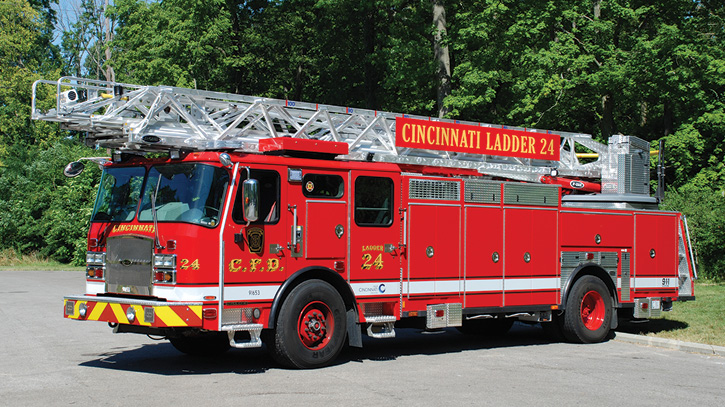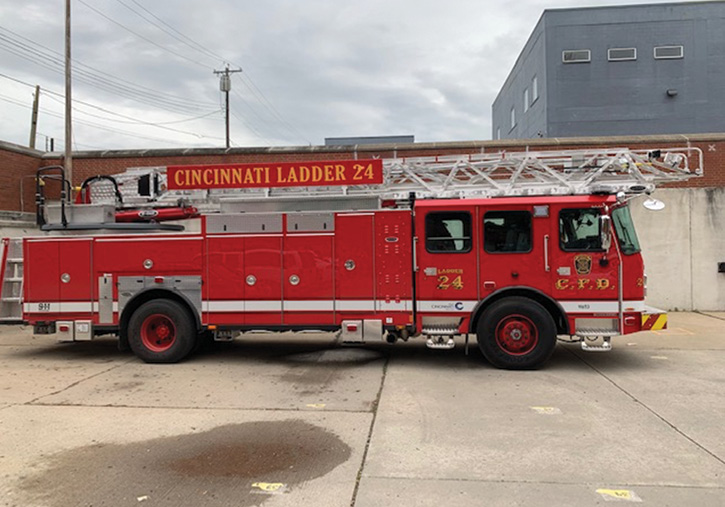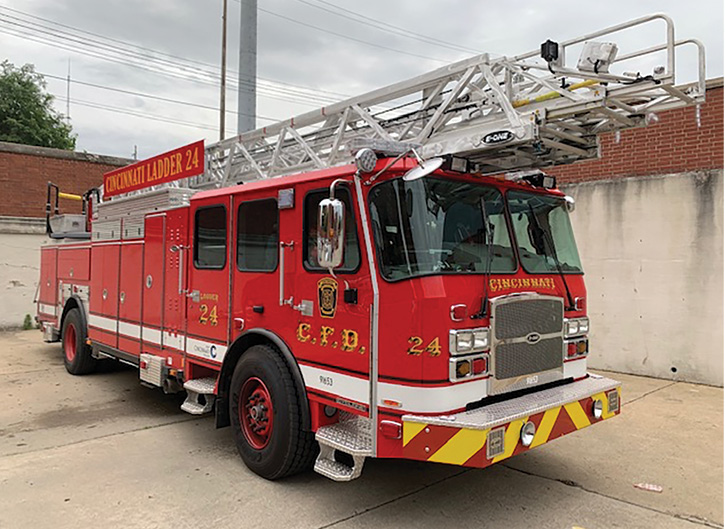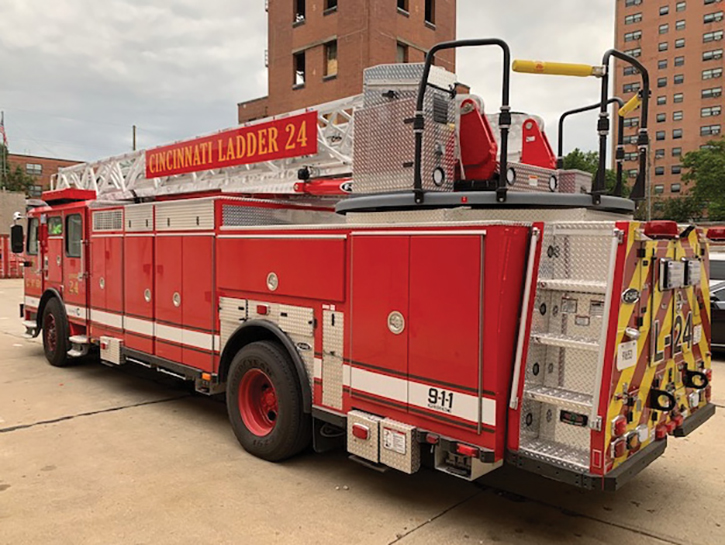
By Alan M. Petrillo
The Cincinnati (OH) Fire Department was in the market for a couple of new aerial ladders but needed the rigs to be height-restricted to fit under some low bridges and in some height-challenged firehouses. Besides the height issue, Cincinnati also wanted a 100-foot aerial ladder that had the narrowest jack spread possible. The department found its needs answered with a pair of E-ONE Metro 100 aerial ladders.

THE TRUCKS
Each of Cincinnati’s Metro 100 aerial ladders is on an E-ONE Cyclone II X 96-inch-wide medium chassis and cab with seating for five firefighters on a single rear axle with a low travel height (LTH) 100-foot aerial ladder without a waterway and powered by a Cummins 500-horsepower (hp) ISX12 engine and an Allison 4000 EVS automatic transmission. Wheelbase on the Metro 100 is 220 inches, overall length is 38 feet 7 inches, overall height is 10 feet 10 inches, and cab-to-axle ratio is 162 inches.
Joe Hedges, E-ONE product manager for chassis and aerials, says E-ONE “brought demo Metro 100 ladders to Cincinnati, considered their special needs, and did quite a bit of customizations to meet the department’s requirements.” He notes that the LTH aerial without a waterway was critical in bringing the rig in under Cincinnati’s 11-foot 3-inch maximum height. “And, the Metro 100’s narrow jack spread of 11 feet using four criss-cross under-slung jacks answers their need for a ladder that can get into tight spaces and set up to operate without any short jacking limitations.”
Nicholas Caliguri, Cincinnati captain, says, “The narrow jack spread was a huge thing for us. We went to the Boston (MA) Fire Department to see how they operated with their Metro 100 ladders and were impressed by what we saw. Our Metro 100 ladders give us great maneuverability and the ability to get into very tight spaces and down streets that often have cars lining both sides.”

1 E-ONE built two height-restricted Metro 100 aerial ladders for the Cincinnati (OH) Fire Department on Cyclone II X 96-inch-wide chassis and medium cabs with seating for five firefighters. (Photos 1-4 courtesy of Vogelpohl Fire Equipment.)
Kevin Kleman, vice president of Vogelpohl Fire Equipment, who sold the two Metro 100 aerials to Cincinnati, along with three E-ONE custom pumpers, says that while the LTH aerial and the narrow jack spread on the Metro 100 were critically important to the department, it also wanted an idle mitigation system on all the vehicles in the order. “E-ONE installed a ZeroRPM® Idle Mitigation system on each aerial and all three pumpers,” Kleman says, “and the department says it plans on putting these systems on all new vehicles it purchases.”
Caliguri notes that when a truck arrives at a scene and the operator puts the vehicle in park and sets the brake, as long as the aerial or a pump on a pumper is not in use, the ZeroRPM system shuts off the vehicle’s chassis engine and powers the warning and scene lighting through lithium iron batteries. “We have paramedics on every one of our trucks and engines, so the system is a very big benefit on [emergency medical service (EMS)] runs,” he says. “We already are seeing some fuel savings by using the ZeroRPM systems, and we hope to have savings in the future in terms of motor rebuilds as well as normal engine maintenance.”
OTHER CUSTOM FEATURES
Hedges says that some of the other customizations that E-ONE did for Cincinnati include a special storage compartment over the left side front wheel for the ladder pipe hose because the aerial doesn’t have a fixed waterway, a 12-inch extended front bumper that’s angle cut for better angle of approach, a raised rear perimeter of the body to give better angle of departure, a rear staircase module narrower than the main body to help reduce tail swing, a low and wide hose storage box on the officer’s side top of the body, and a recessed generator on top of the L1 compartment to preserve the ability to lift the aerial slightly off of its cradle and rotate it.

2 The Cincinnati Metro 100 aerial ladders are powered by Cummins 500-hp ISX12 engines and Allison 4000 EVS automatic transmissions.

3 The Metro 100 aerials carry ZeroRPM® Idle Mitigation Systems that shut off the vehicle chassis engines and power warning and scene lighting through lithium iron batteries.

4 The rear of the E-ONE Metro 100 aerial ladder has a rear staircase module narrower than the main body to help reduce tail swing.
department
Cincinnati (OH) Fire Department
Strength: 850 paid firefighters, 26 stations.
Service area: The Cincinnati Fire Department provides fire suppression, first responder EMS, advanced life support (ALS) transport, arson investigation, fire prevention, and hazardous devices and hazardous material incidents response to the 301,300 population in the 77 square miles of the city of Cincinnati.
Other apparatus: 26 front-line engines, 12 front-line aerial ladders, two heavy rescue units, 12 medic units (ALS transport units), seven reserve engines, and eight reserve aerial ladders.
There’s also customization inside the cab, he adds. “There’s a cabinet built into the driver’s side and seating for five firefighters in H.O. Bostrom seats,” Hedges says. “The driver has a Bostrom air ride seat, while the officer and a rearward facing firefighter are in Bostrom ABTS seats with SmartDock [self-contained breathing apparatus (SCBA)] bottle holders. Two fold-down forward-facing E-ONE rear wall nonSCBA seats have SCBA brackets angled at 45 degrees inboard on the rear wall.”
PUMPER ORDER
The three pumpers that Cincinnati received with the two Metro 100 aerial ladders are built on a Cyclone II X 96-inch-wide chassis and medium cabs with severe-duty interiors and seating for five firefighters in H.O. Bostrom seats. Wheelbases on the pumpers are 176 inches, allowing maneuverability, and the pumpers are powered by Cummins 500-hp ISX 12 diesel engines and Allison 4000 EVS automatic transmissions. Each carries a Hale 1,500-gallon-per-minute (gpm) Qmax pump, a 510-gallon water tank, 20- and 30-gallon foam cells, a FoamPro™ 2002 foam system, and low preconnected handlines.

5 The Metro 100 aerial ladder has a narrow jack spread of 11 feet using four criss-cross under-slung jacks. (Photo 5 courtesy of E-ONE.)
specs
E-ONE Metro 100 Aerial Ladders
- Cyclone II X 96-inch-wide medium cabs and chassis with seating for five firefighters in H.O. Bostrom seats
- LTH100 100-foot aerial ladders without waterways
- Bodies with left and right rescue-style high sides
- Wheelbases: 220 inches
- Overall lengths: 38 feet 7 inches
- Overall heights: 10 feet 10 inches
Cab-to-axle ratio: 162 inches
- Cummins 500-hp ISX 12 diesel engines
- Allison 4000 EVS automatic transmissions
- V-MUX electrical systems
- SCBA bottle storage
- Akron Brass clamp-on ladder pipes
- Harrison 6-kW hydraulic generators
- Whelen LED warning light packages
- Whelen M series LED scene lights
- FRC LED scene lights
- FireTech LED scene lights at rear
- ZeroRPM® Idle Mitigation Systems
Caliguri points out that it was important to the department to have the cabs set up the same on both the ladders and pumpers that E-ONE built. “We want our firefighters to know where all the equipment is located no matter what vehicle they are on,” he says. “We’re really pleased with the pumpers and the aerial. They are good-running vehicles, very maneuverable, fit everywhere, and very solid products that are functionally oriented. Everyone really likes these trucks.”
ALAN M. PETRILLO is a Tucson, Arizona-based journalist, the author of three novels and five nonfiction books, and a member of the Fire Apparatus & Emergency Equipment Editorial Advisory Board. He served 22 years with the Verdoy (NY) Fire Department, including in the position of chief.

